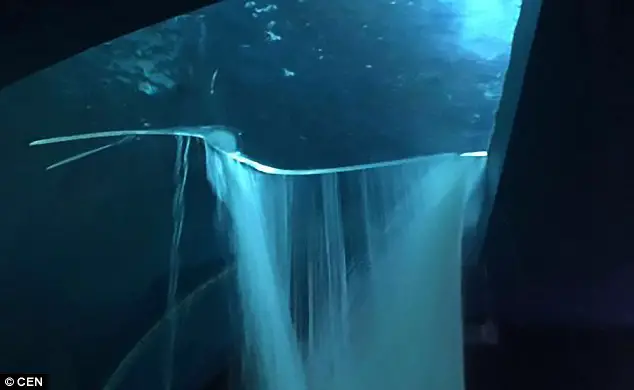Why Aquarium Glass Breaks?
Aquarium glass breaks due to a variety of reasons, including sudden temperature changes and vibration caused by certain equipment inside the tank. When water in an aquarium is heated or cooled rapidly it causes the glass to expand at different rates, leading to cracks and breakage. Vibrations from powerheads, pumps, filters or other pieces of equipment can cause stress fractures in the glass over time.
Additionally, Aquariums that are not properly supported on all sides may be prone to cracking when filled with water as pressure builds up against one side of the tank. Finally, poor construction or installation techniques can also lead to weak spots in aquarium walls which may eventually become large enough for cracks or even shattered panels if mishandled.
Aquarium glass can break relatively easily due to the pressure of the water inside, particularly if it is an older tank or one that has been improperly set up. This is because aquariums are designed to be airtight so that no water leaks out, and when too much weight or pressure builds up inside the tank, this can cause the glass to crack or shatter. Furthermore, even a small leak in an aquarium with inadequate support can lead to structural damage over time as well as sudden catastrophic breaks.
Why Do Fish Tanks Crack? (7 Must-Know Reasons!)
What to Do If the Glass Breaks in the Aquarium?
If you find yourself in the unfortunate situation of having glass break in your aquarium, it is important to act quickly and safely. First and foremost, turn off any pumps or filtration systems that are running. This will help minimize water loss from the tank and prevent any electrical shock hazard from broken pieces of glass coming into contact with submerged equipment.
Next, use a net to remove any fish or other animals living in the tank so they can be placed safely elsewhere. Once all inhabitants are removed, carefully scoop out as much broken glass as possible using gloves to avoid accidentally cutting yourself on sharp edges. You may also need to strain out some smaller shards by passing the water through a fine mesh strainer before discarding it down a sink drain or toilet bowl (make sure there’s no bleach present!).
Finally, clean up any remaining debris inside the tank and around its exterior before replacing substrate material like gravel or sand back onto the bottom surface if needed. If you have spare aquarium-safe adhesive sealant on hand, now would be an ideal time to make sure all seams between panels are airtight once again before refilling with dechlorinated tap water and rehoming those previously evacuated critters!
Can the Glass at the Aquarium Break?
Yes, the glass at the aquarium can break. Most aquariums are made of thick tempered glass that is designed to withstand a certain amount of pressure and force, however if it is subjected to too much strain from things like aggressive fish or other external factors then it can crack or even shatter. It’s important for aquarium owners to be aware of this possibility as broken glass in an aquarium can put both people and animals in danger.
The best way to prevent a tank from breaking is by inspecting it regularly for any signs of wear and tear, ensuring only compatible fish are present in the tank, monitoring water levels closely and never placing heavy items on top of the tank which may cause structural damage over time.
What Does Cracking the Tank Mean?
Cracking the tank is a term used to describe when a fuel tank, such as one found in an automobile engine, has been damaged due to corrosion or wear and tear. This can cause leaks that are potentially dangerous and costly to repair. Cracking the tank occurs when the metal of the fuel tank is weakened by rusting or other forms of deterioration, leading it to become brittle enough for pressure from inside the tank to cause cracks throughout its surface area.
In some cases, these cracks may be visible on the outside of the tank, but more often they are not noticeable until further damage is done through leakage or contamination.The causes for cracking a fuel tank vary; most commonly it occurs due to exposure to water over time which leads to corrosion. Other sources can include poor maintenance practices such as using low-quality gasoline blends and failing to check your tanks regularly for signs of damage or leaking.
In addition, extreme temperatures and physical impacts can create conditions that weaken metal tanks resulting in them corroding and cracking over time.It’s important if you suspect any problems with your fuel system that you have it inspected immediately by a qualified technician who can determine whether there is any danger present before attempting repairs yourself. Repairing cracked tanks requires specialized tools and knowledge so if left unchecked could lead to much bigger issues down the road including potential fire hazards if left unattended too long!
How Long Does Fish Tank Glass Last?
Fish tank glass is an incredibly durable material, but how long it will last depends on a few factors. Firstly, the thickness of the glass plays an important role in its longevity; thicker glass is more resistant to chips and cracks than thinner options. Additionally, regular maintenance and cleaning can help extend the life of your fish tank’s glass since dirt and debris can wear away at it over time.
Lastly, maintaining proper water chemistry levels from day one is essential for ensuring that mineral buildup or corrosion does not damage the tank walls. Generally speaking, with good care and maintenance, you should expect your fish tank’s glass to remain strong for years – if not decades! It’s also worth noting that some tanks come with warranties just in case something goes wrong down the road.

Credit: www.washingtonpost.com
Aquarium Glass Break News
Recent reports have surfaced of a new phenomenon that is affecting aquarium owners around the world. Reports of spontaneous glass breakage in home aquariums are becoming increasingly common and has become known as ‘Aquarium Glass Break News’. While there have been no definitive answers as to why this is happening, some theories suggest it could be due to rapid temperature fluctuations or structural flaws within the tank’s glass.
Regardless, experts recommend taking extra precautions when setting up an aquarium to reduce the risk of damage and keep your fish safe.
Aquarium Breaks
Aquarium breaks are a great way to create a unique experience for you and your family. They involve renting out an aquarium for a short period of time, allowing the participants to observe and interact with different species of fish in their own personal environment. During the break, you can watch the fish swim around, feed them treats, or even take part in hands-on activities like snorkeling or diving inside the tank!
Plus, it’s an educational opportunity – many aquariums offer guided tours where visitors can learn more about marine life and its importance.
Aquarium Break Germany
In August 2019, the largest aquarium in Germany experienced a catastrophic break when a pipe supplying water to its more than 7000 creatures cracked open. The entire facility had to be evacuated and emergency crews worked for nearly 24 hours straight to repair the breach and restore normal operations. Fortunately, only one species of fish was lost due to the accident and all other sea life was successfully saved.
Although it was an unfortunate incident, it serves as an important reminder that even world-class institutions must remain vigilant against potential disasters such as this one.
Hairline Crack in Fish Tank
A hairline crack in a fish tank can be very dangerous as it can cause the tank to leak which can harm your fish. It is important to inspect your tank regularly for any cracks or other signs of damage, and repair them right away if you find any. You may need to replace the entire aquarium if the crack cannot be repaired.
Additionally, make sure that when carrying or transporting your fish tank that you are extra careful not to cause any further damage.
How to Replace Broken Aquarium Glass
Replacing broken aquarium glass can be a daunting task, but it doesn’t have to be. To replace the broken glass, start by draining the water from your tank and then carefully remove any rocks or decorations that are in your tank. Once you’ve removed all of these items, use an aquarium safe silicone sealant to glue the new piece of glass into place and ensure that it is firmly secured before filling up your tank with water again.
Aquarium Glass Breaks Berlin
Aquarium Glass Breaks Berlin is an event that takes place annually in the German capital. It features a unique combination of music, art and glass-breaking performances. The event invites artists from all over Europe to showcase their skills by breaking large sheets of aquarium glass with their bare hands.
This provides a mesmerizing spectacle for attendees, who can also enjoy live DJs spinning tunes throughout the night.
Will a Scratched Aquarium Break
No, a scratched aquarium will not break. Aquariums are made of strong glass that is designed to withstand scratches, chips and minor cracks without compromising the integrity of the tank. However, it is important to repair any deep scratches or cracks as soon as possible in order to avoid long-term damage.
In addition, if you’re concerned about how a scratch will look aesthetically in your aquarium, there are many ways you can hide or fix it with sanding techniques or clever decoration ideas!
Aquarium Scratch Or Crack
An aquarium scratch or crack can present a serious danger to your aquatic life. Even small scratches and cracks on the walls, floor, or lid of an aquarium can create openings that allow water to leak out. This not only puts your fish at risk but also causes problems with temperature regulation, pH levels, and nitrogen cycling in the tank.
It is important to inspect your tank regularly for any signs of damage so you can act quickly if needed.
Conclusion
In conclusion, aquarium glass is a delicate material that can break easily and cause injury or damage to your tank. It’s important to take all necessary precautions when cleaning or moving an aquarium in order to protect both the fish and yourself from harm. Taking basic steps like using rubber-coated gloves, double-checking for any sharp edges, and testing the strength of the glass before attempting any major changes can go a long way in preventing avoidable accidents.






